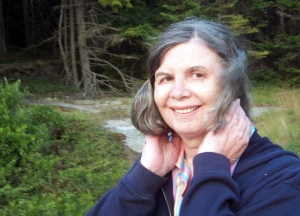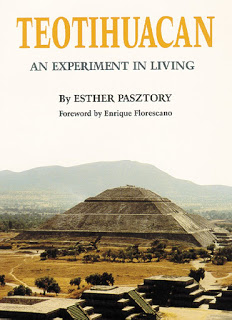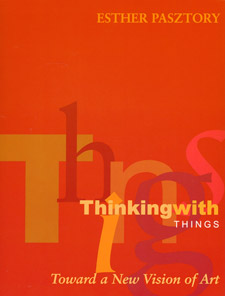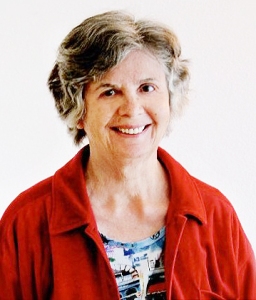
Art is not for just looking, it is necessary for thinking. – Esther Pasztory, Thinking with Things (2005)

Esther Pasztory in her own words:
I came to the US as a refugee at the age of thirteen during the Hungarian Revolution against communist Russia in 1956. My father was an architect. I went to the opera in Budapest as a child several times and wanted to be a costume and set designer. Some years later, at Vassar, I took an art history course to familiarize myself with styles. I liked the intellectual aspects of art history more than the practical application.
Transferring to Barnard after my marriage, I had a lot of required courses to take, including anthropology and geology. Sylvia Broadbent, sent us to write about some kind of “Primitive Art.” My eye happened on Ashanti gold weights. I was astonished that there was “art” south of the Sahara. I wanted to know what else there was in the world that I didn’t know anything about. I went to graduate school in art history because I could no longer change my major. ( I might have liked historical geology.) As it was, I chose “Primitive Art” which in those days included Pre-Columbian Art.
It was the 1960’s with the beginning of the counterculture, the Peace Corps, the interest in non-western cultures, seeking after Eastern religion. In New York, Primitive Art had its own museum only since the late fifties. Although its adherents were few, it was the leading edge of art history. We considered ourselves superior to tired old western art history.
I studied with two Primitive art pioneers, Paul Wingert and Douglas Fraser, but at Columbia I had the opportunity to take courses with Meyer Schapiro, Margaret Mead, Ruth Benedict, Hans Himmelheber, Ed Lanning, Alan Sawyer and Gordon Ekholm. It was my good fortune to have as classmates, the Pre-Columbianist Cecelia Klein, the Africanist George Preston and the Oceanist George Corbin. Following up on my initial interest in African art, to wrote my Master’s Essay on ‘Group Composition’ in African Art. That got whittled down to scenes in which a major figure was flanked by attendants, which I called, not quite rightly, “Hieratic Composition.” My examples from Ghana, Nigeria and Cameroon suggested that such scenes were only found in ranked societies. It was published in The Art Bulletin in 1970, the first African art article published in the very western Art Bulletin, the official journal of the College Art Association.
Fieldwork in Africa was too daunting, so I chose to write my dissertation on Mesoamerica and went to visit Mexico. I was incredibly impressed by Teotihuacan, it was the ultimate stage set, and fascinated by its mural paintings. Little was published or known about them. No one in Mexico specialized in them and in the US I met Arthur Miller the only one who was finishing a dissertation on “all” the murals I then met the members of The Teotihuacan Mapping Project, Rene Millon, George Cowgill, Warren Barbour, Michael Spence and Evelyn Rattray among others. I learned that Clara Millon had written an unpublished dissertation on the chronology of the murals. I chose to concentrate on the most interesting murals at the time in the apartment compound of Tepantitla, for a 1971 degree. Tepantitla had been excavated in the 1940’s by Pedro Armillas, but had not had a major study. (The Murals of Tepantitla, Teotihuacan, (Garland Publications, New York, 1976.)
Despite a lot of stylistic and iconographic analysis, I did not get very far in understanding Teotihuacan. I noted that there were deities besides Tlaloc, whose gender was unclear, perhaps female. A redrawing of the little scenes I saw as ritual, have been very useful to me and other scholars. Because Teotihuacan was then considered “sort of “ like the Aztecs, I thought that I could interpret them better if I immersed myself in Aztec culture. For the next years I concentrated on Aztec art.
There was no one book in which there were illustrations of all major Aztec works of sculpture and it seemed sensible to publish such a book. The publisher I contacted thought he could sell the book better if it covered all Aztec media, and therefore I included architecture, featherwork, figurines and pottery in” Aztec Art.” This was the first book on Aztec art. ( Abrams, New York 1983, subsequently University of Oklahoma Press, Norman) I was fortunate in that my student, Emily Umberger, had, for the first time, analyzed the historical content of the sculptures in her dissertation providing new data as well. My major discovery , more implicit than explicit, was that there wasn’t “one” Aztec art, since different parts of Aztec society were involved with different images
The well known large scale images with horrific symbols of skulls and sacrifice were mainly on the main temple (Templo Mayor) intended partly for the gaze of the neighboring elite. Ordinary Aztec temples usually had statues of fertility deities such as Tlaloc, Ehecatl, Chalchiutlicue and Chicomecoatl of simpler form and benign aspect. The most numeroous Aztec statue was of Chicomecoatl – the maize goddess. In the countryside, the common images were benign figurines of women and children, who bore no resemblance to any of the other sculpture categories. I was curious to find out whether Teotihuacan had such a complex image system.
In 1976, a San Francisco architect named Harald Wagner died and left the De Young Museum of San Francisco some two hundred Teotihuacan mural fragments (many were very small) The Museum asked me along with Rene and Clara Millon to study and publish them, resulting in the volume, “Feathered Serpents and Flowering Trees: Reconstructing the Murals of Teotihuacan.” (Berrin 1988)Clara and I divided the murals in half. Rene found the location from where the murals were looted from and excavated there, finding new murals. He named the exceptionally large apartment compound Techinantitla. I was asked to write a general, introductory chapter on Teotihuacan as a whole for the volume. (Pasztory 1988)
With two colossal exceptions, Teotihuacan did not have monumental sculpture representing either rulers or deities like the Aztecs. There were abundant small figurines, incense burners, pots with no apparent class distinctions. To me, the most unique features of Teotihuacan were the estimated 2500 apartment compounds built out of masonry many with high quality mural paintings. They suggested to me both a high standard of living and the potential to have had some say in the running of the city. I suggested that Teotihuacan might have had some kind of a “collective,” “corporate,” “participatory” government. (I didn’t know the right word.) I showed my essay to Rene Millon who had taken a mentor role towards me. He was vehemently against the idea. “The pyramids were not built by committee” he said.” He insisted that only a powerful monarch could have built Teotihuacan In a negative way, my idea entered the discussion. I retreated.
While we were working on the Wagner murals volume, the De young Museum came up with the idea of a general Teotihuacan exhibition and asked me to be the scholarly curator with Kathleen Berrin the museological curator. That was an exciting project in which I hoped to bring together all the major Teotihuacan works of visual interest. I wanted to bring out the Teotihuacan aesthetic of flatness, abstraction, decorative and iconographic complexity as well as their enigmatic aspects. I was going to connect this aesthetic with my idea of the non-aristocratic, collective aspects of societal organization at Teotihuacan. The show, with its accompanying catalogue, Art from the City of the Gods, opened in 1993. It was the work of many people in the Museum and in Mexico. In the end the catalogue was written by twelve scholars from varying points of view. The exhibition emphasized the then popular idea of “treasures of …” displays. My original ideas were lost in the shuffle. The Catalogue is a valuable compendium of Teotihuacan images and the essays are useful of where Teotihuacan studies were then.
It became evident that if I wanted to get my ideas about Teotihuacan developed I would have to write a book. As there was no general book on Teotihuacan, I chose to pull together the data available to me and write a “story” for a wider public. Millions of people visited the site of Teotihuacan every year and had no idea where they were. This was the first book on Teotihuacan. “Teotihuacan: An Experiment in Living,” 1997 Oklahoma University Press.)  ( The book lists all my previous Teotihuacan articles.) The book had three general aims; to separate Teotihuacan from the Aztecs; to give Teotihuacan an identity – the way Maya, Olmec and Aztec have identity and are therefore “visible.” And to analyze the structuring principles of the visual arts and find what they suggest about the structuring principles of the city. As the study of Aztec art had helped to reveal the different uniqueness of Teotihuacan, Poststructural philosophy especially Roland Barthes, gave me courage to interpret society from art, rather than the usual other way around. Either way, I confirmed my original insight that Teotihuacan had a collective ideology if not a somewhat collective government. Since anthropology then had as its basic tenet that the early state was monarchic and absolutist, these ideas were controversial. Now think that, like the Roman Empire, the long time span of Teotihuacan could have had both Republican and Monarchic governments at different times.
( The book lists all my previous Teotihuacan articles.) The book had three general aims; to separate Teotihuacan from the Aztecs; to give Teotihuacan an identity – the way Maya, Olmec and Aztec have identity and are therefore “visible.” And to analyze the structuring principles of the visual arts and find what they suggest about the structuring principles of the city. As the study of Aztec art had helped to reveal the different uniqueness of Teotihuacan, Poststructural philosophy especially Roland Barthes, gave me courage to interpret society from art, rather than the usual other way around. Either way, I confirmed my original insight that Teotihuacan had a collective ideology if not a somewhat collective government. Since anthropology then had as its basic tenet that the early state was monarchic and absolutist, these ideas were controversial. Now think that, like the Roman Empire, the long time span of Teotihuacan could have had both Republican and Monarchic governments at different times.
I had a big project I had wanted to do since the 1970’s. In the 1970’s I was very interested in Elman Service and the neo-evolutionist archaeology writers. As soon as I read them, I saw how the various categories of band, tribe, chiefdom, and state could match up with “Primitive Art” and Western art history, explaining each other. Western art history believed in a development model of abstraction and conventionalization turning into realism by gradual stages of evolution. This was based on Egypt and the Greeks. The levels of social complexity model matched up with a global “primitive Art” amazingly well. There, there was no stylistic development in either direction. Each level of complexity required different forms and styles. Tribes preferred geometric forms, chiefdoms shiny things. Moving from one to the other required transformations in the objects needed.
I gave the draft to a few friends to read, all of whom were against it. They called it “totalizing” theory and thought that such should not be written at all. I wrote this book twice: first as a long winded and apologetic narrative entitled Toward a Natural History of Art. The second time short and succinct with an introduction about what “art” was and wasn’t. I argued that the modern concept of art derives from the eighteenth century and does not fit the situation before it. There is no such thing as “art” there are only “things” some of which we Westerners designate as” art.” There is artistry, which is a means to an end. The aim of it is communication which is all important especially in societies without writing. I argued that the aim of all “art” was cognitive and only secondarily visual delectation. The visual was a means to a cognitive end. After bands, tribes, chiefdoms and states I added two more categories: the literate state and the industrial state to bring the sequence up to the present. The new title of this concise account became “Thinking with Things: Toward a New Vision of Art,” University of Texas Press, Austin 2005.
There is artistry, which is a means to an end. The aim of it is communication which is all important especially in societies without writing. I argued that the aim of all “art” was cognitive and only secondarily visual delectation. The visual was a means to a cognitive end. After bands, tribes, chiefdoms and states I added two more categories: the literate state and the industrial state to bring the sequence up to the present. The new title of this concise account became “Thinking with Things: Toward a New Vision of Art,” University of Texas Press, Austin 2005.
In Thinking with Things I also republished seven theoretical articles written previously. This book found most of an audience abroad. (An Arab translation was discussed but didn’t happen due to the political situation in the Middle East.)
Many of my subsequent works were based on the problems of Western reception because I came to the conclusion that no matter how hard we try, we see alien arts through a Western filter.” Jean Frederic Waldeck : Artist of Exotic Mexico,” University of New Mexico Press, 2010, was an account of the first Western artist to go to Mexico on his own to find fame and fortune rendering the Maya ruins of Palenque in the beginning of the nineteenth century. He was the first to valorize it as “art” and not documentation. I was interested in European art theory and exoticism at the time. Waldeck’s absurd misunderstandings were a part of the attraction. This was the first book on Waldeck in English.
I found it peculiar that Mesoamerican scholars had so little discussion and explanation of human sacrifice. In three articles I tried to understand both the anthropological meaning of the practice and the various Western ways of thinking about it and judging it. “A Civilization going Mad: The Aztecs in Western Thought is one in, Arqueologia y historia del Centro de Mexico, Homenaje a Eduardo Matos Moctezuma, ed.by. Luis, Lopez, Lujan, David Carrasco, Lourdes Cue, INAH, 2006, pp.637-644.
I have been interested in fakes since I saw that two important Aztec stone masks in the British Museum were nineteenth century fakes. (Reprinted in Thinking with Things.) In “Truth in Forgery” I analyzed why people prefer forgeries to real things That talk was a part of the symposium at the Metropolitan Museum that I organized in 2000. Entitled “West by Non-West” I had hoped that the speakers would discuss the subliminal ways we prefer Western values while ostensibly analyzing Non-western themes. The conference would have been published as an edited book, but I was diagnosed with breast cancer and could not do it. Francesco Pellizzi published most of the papers in a special issue of the Journal RES: Anthropology and Aesthetics, in 2002, no.42.
Staying with Western attitudes in 2015 I published a little book entitled, “Aliens and Fakes: Popular Theories About the Origins of Ancient Americans.” I was interested in crazy theories like “Lost Tribes of Israel” and landing fields on the Nazca lines, not just to debunk them but to understand why people believe in them. Fakes I saw as the crystallizations in material form of such ideas.
While in the 1960’s, when I started, traditional “Primitive” societies still functioned in many parts of the world, by the 1990’s as a result of globalization, modernization transformed most of them. The objects of interest were mostly in museums and no longer in the field. Interest shifted away from what came to be called “classical” Non-Western art, something of an oxymoron, to contemporary Non-Western art. Australian Aborigene acrylics, Inuit stone carving, artists exhibiting at Cannes and published in Vogue Magazine. Interested in the phenomenon I organized a team-taught course at Columbia that was given several times and was influential outside of the university. It was called “Multiple Modernities.” Though a book never materialized, I put my introduction on the web. “Multiple Modernities – Paradigm Shifts in the Western View of Exotic Arts,” in 2010.
From the beginning, I always taught Andean Art as well as Mesoamerican art. In the 1990’s I was commissioned by a British firm to write a book on “Pre-Columbian Art” that included both. That was my chance to pull together my ideas on the Andes that students were generally fascinated by.( 1998, Cambridge University Press.) Although I wanted to change the title, the firm insisted on “Pre-Columbian.” By then it was clear that the term “Pre-Columbian” did not mean anything to people in the US or abroad and it needed to be scrapped. Slowly, I began to favor the term “Ancient American” The small Pre-Columbian Art book was very popular with classes in the US until it sold out.
Although I was never an Andeanist and didn’t consider myself as such, I wrote a book on special features of Andean art that, as an outsider I found different from Mesoamerica and particularly interesting. The textiles, the Inca rock sculptures, the tendency to abstraction and minimalism. I also felt that Andean art had been neglected by scholars and I could make a contribution. Trying to publish it, however, proved impossible. Three different sets of Andeanist reviewers panned it. Claiming some that I was not up on the latest here and there – something that was easy to correct- their main objection was that I was a “well-known Mesoamericanist” and they did not want me on their turf. They actually said so, one was positively hostile. As I was close to retirement, and such an illustrated book was a large undertaking, I did not want to keep trying. Unattractive typescript as it was, I put it on the web. A few Andeanists found it useful. “Inka Cubism: Reflections on Andean Art” 2010.
I retired in 2013. A symposium was held in my honor and a Festschrift was published partly as a book and partly on the web. The book, “Visual Culture of the Ancient Americas” ed. By Andrew Finegold and Ellen Hoobler,( former students), Oklahoma University Press, 2017. In a brief afterword I expressed the hope that in future there would be a universal art theory that included the knowledge gained from Ancient American art. The Festschrift articles on the web are on non- Ancient American topics. The authors of both are Cecelia Klein, Leonardo Lopez Lujan, Gary Urton, Georgia de Havenon, Kathleen Berrin, Holland Cotter, George Preston, Richard Townsend and Polly Nooter Roberts. Also, my former students, Joanne Pillsbury, Cynthia Conides, Jennifer von Schwerin, Jeff Kowalski, Susan Milbrath, Janice Robertson, Lois Martin, Timothy King, Kate Morris, and Robert Bradley.
I expected to write nothing further on an Ancient American topic after my retirement. I moved from New York to Maine. In 2016 the BBC contacted me to participate in a new series called “Civilizations” (emphasis on the “s”). They liked “Thinking with Things” very much and wanted me to talk on the Olmec heads, realism and faking. I did my best. After I left I realized that I never mentioned that they were carved with stone tools. And there were a whole lot of things about Ancient America that I did not mention. I made a list of the things I should have liked to mention to the BBC. The list kept getting longer and I decided to put it in writing. A long Maine winter was beginning.
The title of this book is, “Stone Age Civilization “and it is about how a Stone Age culture created civilizations in Ancient America. This book is not culture by culture, but thematic, focusing on achievements and contrasts with the Old World. Not surprisingly, Teotihuacan plays a role in it.
